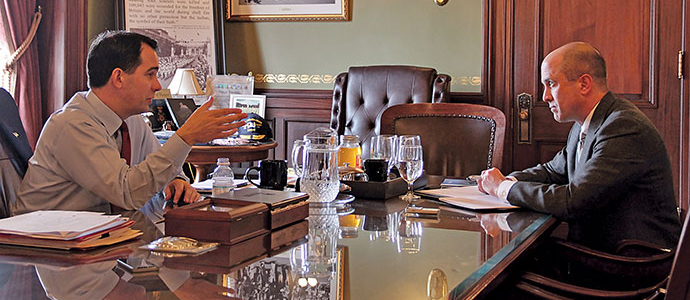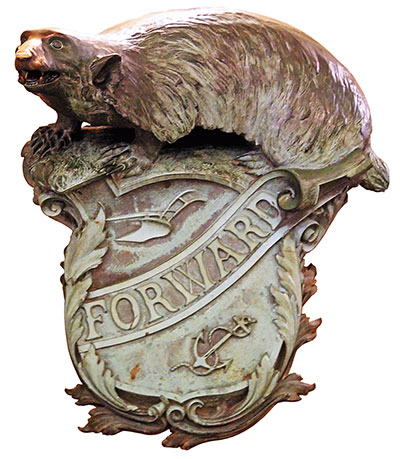If, probably when, Wisconsin Governor Scott Walker wins re-election in November, it will be the third time he has done so in four years. First elected to the office in November 2010, Gov. Walker won a recall election in June 2012, beating Democratic challenger and Milwaukee Mayor Tom Barrett more handily than he did the first time around. Walker is the first US governor to survive a recall election, signaling support at the time on the part of most Wisconsinites for the governor’s budget repair plan, fiscal conservatism and determination to rein in public employee unions. He accomplished the latter chiefly by curtailing collective bargaining rights, likely sparing the state’s municipalities from a future mired in fiscal quicksand.
On March 24th, Gov. Walker signed his Blueprint for Prosperity (Special Session Senate Bill 1) into law, directing the Dept. of Revenue to adjust withholding tables to reflect tax cuts and inflationary adjustments to the standard deductions and withholding brackets. It also provides $406 million in property tax relief and cuts income taxes by $98.6 million. Another Blueprint component is a $35.4-million increase in funding for the Wisconsin Fast Forward program, which supports education and workforce-training initiatives.
The governor’s name already is on early lists of potential GOP presidential candidates for the 2016 general election, thanks in part to his leadership in handling the 2011 state budget and ensuing public employee union flap.
For now, Scott Walker is content to talk about how that episode translates into a markedly better business climate and why a right-to-work legislation campaign is not imminent, despite it being made law recently in two nearby Midwest states. The governor discussed these and other topics in his Wisconsin State Capitol office in Madison with Site Selection Editor in Chief Mark Arend on March 12th. Following are excerpts:
Site Selection: How has Wisconsin’s business community responded to steps you have taken since 2011 to shore up the state’s fiscal situation?
Gov. Walker: Four years ago, when I was running for governor, a survey of employers found that just 10 percent thought we were headed in the right direction. At the beginning of 2014, the same survey said that 95 percent of our employers think we’re heading in the right direction. I’d like to know what’s up with the other 5 percent. But that’s a tremendous turnaround in terms of the feelings of employers within the state. As much as we would want those from other places to come here, we first and foremost want to make sure we are creating a good environment for people who are already employing people in our state.

Gov. Scott Walker and Site Selection Editor in Chief Mark Arend.
Photos by Soo Jones Kelley
“We have reined in frivolous and out-of-control regulations, and we now enforce common sense, not red tape.”
The proposal I will sign in about two weeks [signed March 24th], the Blueprint for Prosperity, will reduce taxes by $2 billion. It’s a start, but my neighbor in Minnesota just raised them by $2 billion last year. The US Chamber of Commerce gave us an award two years ago for having some of the most aggressive lawsuit reform in the country. We have reined in frivolous and out-of-control regulations, and we now enforce common sense, not red tape.
We’ve made some tremendous gains there, and it wasn’t just through the economic development corporation, it was through all of our state agencies, which are very much focused, including our regulatory agency, on how to make it easier, how to be proactive and help employers and property owners so that we are in a position where we are helping them. We all want clean air, clean water and public safety and public health, but how do we do that in a way that is proactive? That’s why you see such a marked turnaround both within the state and for those who have recently looked at our state in terms of the business climate. It’s much more positive than ever before.
SS: You recently attended a gathering of site consultants — the Site Selectors Guild — in Denver. What did you hear from the consultants about their impressions of Wisconsin?
Gov. Walker: They talked about how dynamic the turnaround has been. We replaced the old Department of Commerce with the Wisconsin Economic Development Corporation, the sole purpose of which is to help grow business opportunities in Wisconsin. There is now a much different attitude, an aggressive approach, and really one where the perception out there is not just about my approach or my lieutenant governor’s approach but our whole administration: We understand that not every one of the consultants’ clients will be the right fit for Wisconsin. We’re not naively saying to them, ‘Bring everyone — we’re perfect for them.’ But we tell them that we do make a compelling case for many of them. So for those that might be a good fit, what can we do to help you? We are realistically telling site selectors about our strengths, but we are candid about potential weaknesses and what we are doing to correct them or offset them. Site selectors have found it interesting that clients assume, for example, that the cold in the winter months is a negative in terms of work attendance, when it’s just the opposite. Most people never miss work.
We have unique features — certainly proximity to the Chicago market, the Great Lakes; infrastructure is a huge deal. Because of our dairy history we have one of the most significant paved infrastructure systems in the country — not just Interstates, but state highways, rail, ports, airports — a very comprehensive system. With the ports on the Great Lakes, we get around the world via the St. Lawrence Seaway and to our biggest trading partner, Canada. Infrastructure is a very big deal to us.
Cost-effective and reliable sources of power are a significant asset throughout Wisconsin. Something people don’t generally think about, especially if they are looking to site something where they have multiple locations around the country, is we are one of the few areas where if you take a map and draw a circle around areas with traditional natural disasters — earthquakes in the West, hurricanes on the Gulf Coast and East Coast, tornadoes in the Central Plains, for example, Wisconsin is free of those. So someone looking to put data centers in, for example, will know there will not be a disruption in their ability to deliver services. It’s a pretty compelling case.
SS: Let’s turn to the labor climate now that the dust has settled on the public-sector side. What do readers need to know about Wisconsin’s labor dynamics on the private-sector side?
Gov. Walker: Wisconsin’s work ethic is a real strength. We hear repeatedly from our employers that when they start up operations elsewhere in the country, more often than not they bring crews in from Wisconsin to teach the work ethic. This isn’t unique to Wisconsin, but worker shortages in key industries like advanced manufacturing, IT in particular and some healthcare related fields can be an issue.
Now, I’m not a big spender, but in the last budget I invested more than $100 million into worker training and career development for everything from a short-term, multi-week customized worker-training program to more money for our technical colleges. Our University of Wisconsin System is the first public system in the country with a flex option for more engineering and IT decisions and healthcare. We are trying to very specifically address the issues of not just jobs that are open today, but for employers who are either looking to come here or looking to grow here and what positions are open tomorrow and in the next few years.
“We can now pay teachers based on performance, meaning we can put the best and the brightest in our classrooms. To a lot of our employers, that’s a big deal.”
We have been very aggressive in trying to get ahead of the curve on that. We have a strong work ethic. With the baby boomer generation at or near retirement, we want to be out front, leading the way in terms of investing enough and in the right way to make sure there is an adequate, steady supply of well-trained, well-prepared, hard-working employees there.
In terms of organized labor, the interesting thing is we did right-to-work for all public employees as well as the pension funding and other changes. As an aside, we’re the only state in the country that has a fully funded pension system. I have some of the lowest pension and debt per capita in the country. I have a rainy day fund that is 165 times bigger than when I took office, and I paid back all the past-due bills. [This is of great interest to companies] when we recruit businesses, though most of our bread and butter is still helping our existing companies grow.
Particularly along the Illinois border, and increasingly along the border with Minnesota, but Illinois particularly, a lot of businesses have come north. Something I hear time and time again is it’s not just that the business climate has dramatically improved, but stability is important to them. They look at my neighboring states and see a pension system that is half funded and they don’t know what the future holds. Then they look at us and say, ‘They’re locked in. When they make a promise, I can take it to the bank.’ Our bond rating is strong, and their bond rating is in the tank. Those kinds of things make a difference.
Back for a minute to organized labor. Even though our right-to-work only applies to public employees, there is such a small percentage of our working population that is unionized outside the public sector. Even though we don’t have a right-to-work law, the practical effect has been that most of the private-sector unions that are still here have dramatically increased their relationships with management because of the pressure of what we did on the public side. They are trying to avoid the next step, which would potentially be right-to-work legislation. So they are trying to avoid giving examples of where it’s problematic.
We have found almost de facto that without right-to-work, employers are seeing some of the benefits in that unions that are here are working much better with their employers, and there has not been an aggressive push to add to the unions, because they are trying to move their fight somewhere else.
In this current legislation session, the reason we did not push to enact right-to-work legislation is because I heard so much from the employers in the state, saying, ‘We like what you’re doing, we like the aggressive tone you took, we like the way you’ve balanced the budget and changed the climate. And after a couple of years of protests and recalls, we just want some quiet, some stability.’ Even those who are long-time proponents of right-to-work said that perhaps we should relax a little bit. So we responded to what we heard from employers.
SS: Even though Indiana and Michigan have taken that approach.
Gov. Walker: We’re watching that. But the interesting thing in our case is that our competition isn’t just our direct neighbors. Really, our two biggest neighbors in terms of urban areas are Minnesota with the Twin Cities and Illinois with Chicago. Neither of those states have, nor are they likely to have, right-to-work laws. It’s not that it’s never being discussed, but it’s one of those issues where our employers and chambers and others have not felt the pressure. There definitely was pressure before our reforms, but the de facto effect is that it has brought about a diminished role for organized labor, even outside the public sector, because what we did there had a ripple effect on the private side.
SS: What is your strategy for keeping university students from leaving Wisconsin when they graduate?
Gov. Walker: We actually do pretty well on the issue of brain drain. Our rate isn’t any higher or lower than before, but when we look at the needs for the common workforce, we’ll have to be more aggressive at keeping people in the state, particularly with the baby boom generation [maturing]. There will be an abundance of openings not only in our four-year colleges and universities but in our two-year technical colleges. We’re reaching out not only to existing students approaching the end of their time at the comprehensive four-year campuses, but going not only into Madison, but Chicago and the Twin Cities, because we have a significant number of alumni from the University of Wisconsin who work in those areas to recruit them back to Wisconsin. Part of it is a marketing campaign.
It’s been easier financially for students to stick around in that for the first time in the state’s history we’ve frozen tuition for two years in a row on UW campuses. And when I am in other places around the US and the world, we try to make connections with alumni not only to tell them we’d love to have them back, but to hear their insights on businesses and individuals we might recruit to Wisconsin

Photos by Soo Jones Kelley
SS: What perceptions about Wisconsin do you have to address when you’re meeting with people outside the state?
Gov. Walker: The business climate comes up, as we’ve mentioned. But sometimes it’s not so much a matter of having misperceptions. It’s that they don’t have the full picture. A lot of people may have heard about the battles we had with the public employee unions, but they don’t realize it goes beyond just a balanced budget and a surplus. We no longer have tenure, for example, in our schools. We can hire and fire based on merit. We can now pay teachers based on performance, meaning we can put the best and the brightest in our classrooms. To a lot of our employers, that’s a big deal. They look at that not only for prospective employees but even for their current employees who they are trying to get to stay. And when they’re recruiting on the East and West Coasts, they can point to how much better the schools in Wisconsin are now because of the reforms that have taken place.
Also the cost of living is lower here, and that is a major benefit to employees, including in terms of real estate costs. But our schools are now some of the best in the country. We consistently have some of the top ACT scores in the country, far above the national average. Usually, Wisconsin, Iowa and Minnesota are competing for the top ACT scores.
That has been a consistent fact and it has continued to grow since I have been governor. Admission rates are up, third-grade reading scores are up. All the major indicators are going in the right direction.
Part of it is quality of life — you get all the big-time amenities of a cosmopolitan city like Milwaukee with professional sports, a zoo, a museum, with a much easier cost of living, easy traffic times, and this is true of other markets around the state.
Some like to talk about ‘fly-over country,’ but we’re surrounded by two Great Lakes and the greatest river in the US, and we have 15,000 inland lakes, which is 5,000 more than Minnesota. You can put your business in a location that makes a lot of sense, and you’re never far removed from a lake, river or other recreational opportunity. It’s the benefit of both worlds.
